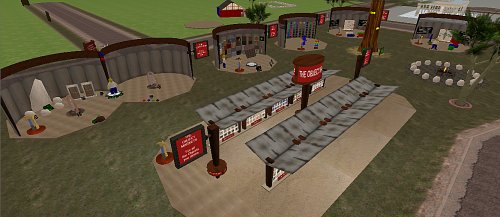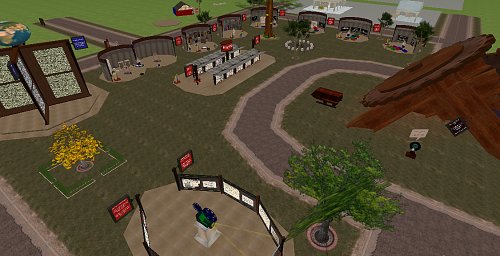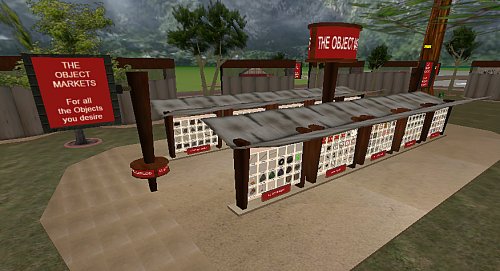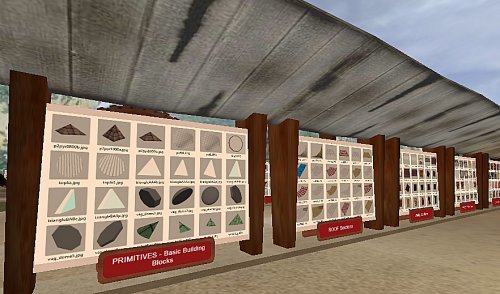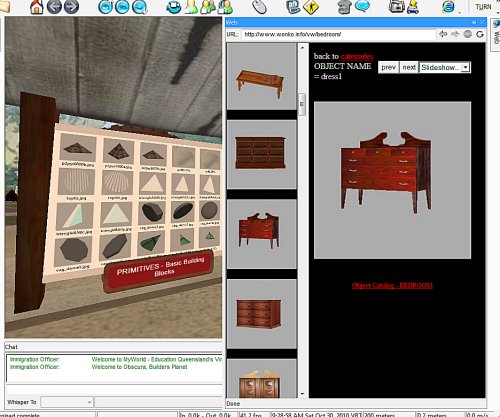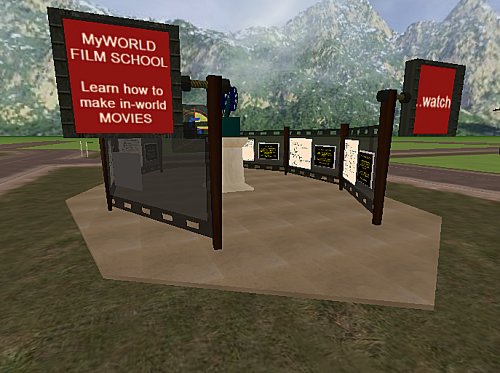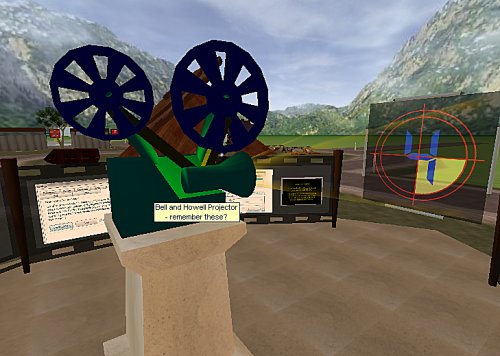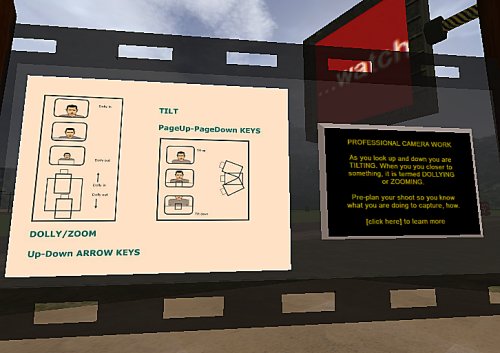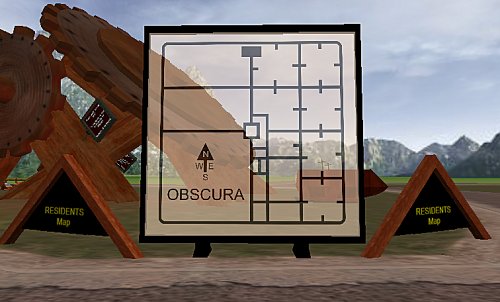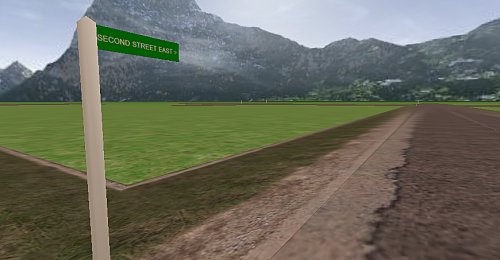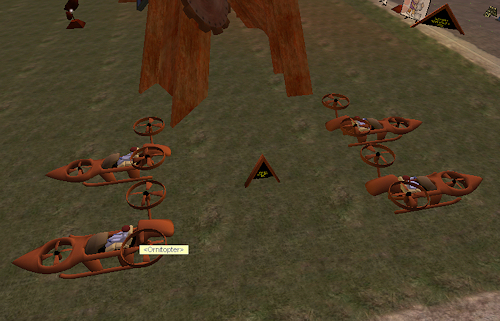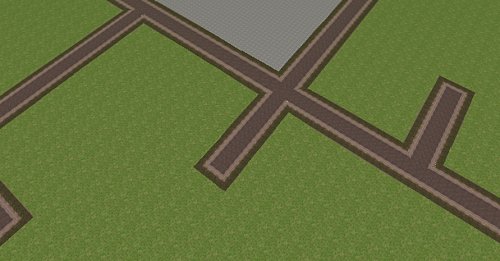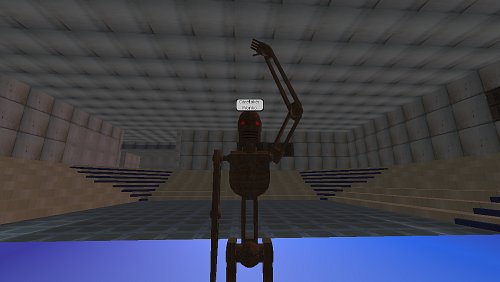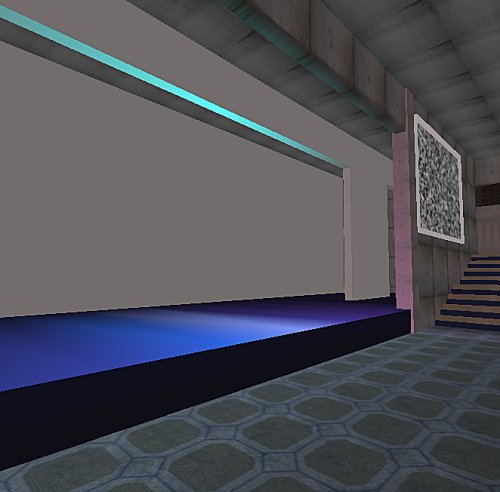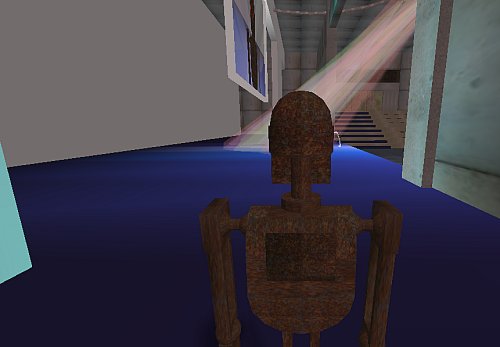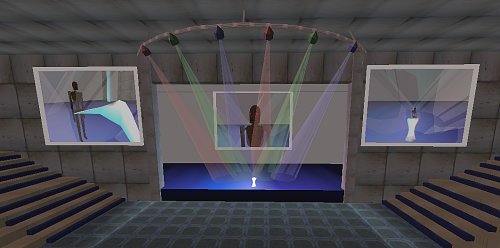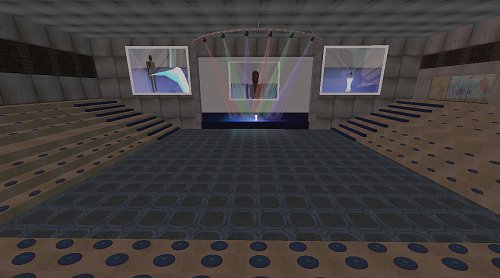Tutorial Zone complete?
…so I got to thinking about the overall “sense” of the tutorial zone – never a good thing when I have lots of other things to do, but the new procrastination plugin kicked in and I ignored my streaming head cold symptoms and began tweaking…
It seemed to me that the tutorial “shells” were facing the wrong way (they faced the road and had their backs on the internal lawn area) – by rotating them 180 (and re-arranging the foliage) it feels a lot more inclusive, like the tutes and the object market relate to each other – they are ALL about the art of building so that was settled (at least in my own fevered brain).
I added a campfire talk circle, with a “cone of silence” around it so private group discussions can go on there, re-jigged the guided tour a little so it made sense and I think I am pretty well done here.
Looking at it from above, it looks like there is very little here, but I know how long it has taken me to make, and feel pretty proud of it.
In the one compact u-shaped area we learn how to make, move, rotate, scale, colour, texture, script and select objects, how to film them afterwards and share our plans for doing so – nice, compact, accessible and … yeah, I know, talking to myself, you get that.
What is missing? Suggestions gratefully received.
…iObject 0.9b
…so we had an immediate need to provide an in-world object catalog for builders, and the conventional “object yard” is not something I want to so, so we are looking into database solutions
For weeks, LP staff popped objects and screen captured images, carefully naming them. I then (laboriously) categorised them and eliminated duplicated (historical collections of objects had spawned many copies), creating a categorised collection of objects.
To provide punters with an idea what the category is all about, I included some screenies of typical assortments. Each panel links to the category in the in-world browser also, which is sort of cool. Not sure if there is a simpler/more intuitive way to do this but I think this approach should work.
I used a gallery script that automatically creates thumbnail-index framesets from a folder of images, and this will later morph into the consultant-built database solution (after I can convince someone to do the data entry).
Next up a couple of panels on builder work-flow and they should be away.
…you ought to be in movies
…so Cybernauts will need to present their final contributions, and one format will be in-world machinima, so I set about thinking about how to best teach how to do this.
I have fond (if wildly inaccurate) memories of the old clackety film projectors we had when I was in school, so set about modelling one in Wings3D
While I was there, I also made a “wall” that is to be used as a sort of noticeboard on which I post tutorials and how-to’s. I thought the filmstrip metaphor would be a useful one so used that – I suspect however, our cybernauts have NEVER even seen actual film (that flimsy semi-transparent media we used to entrust our visual records to) – good or bad I do not know. I am not sure how I feel about the move to entirely digital records, particularly of things that are important – I guess they will never be accidentally deleted or become corrupt, hey?
With assets in-hand, I entered the world, set up an area in the tutorial zone, wired it to be the next stop in the guided tour and began decorating it with film-making resources
I popped the projector on a pedestal (where it belongs :P) and began animating and lighting it – the reels move at different speeds, as they did in real life, and I found a rather nice animated test pattern, and fashioned a transparent flickery light beam to add to the effect. Surrounding this I set about arranging display panels.
The aim was to “keep it simple, stupid”. Fortunately the in-world video capture system is pretty simple actually, so I aimed to show budding Spielbergs how to get to it, how to drive it and what the settings mean, briefly.
As well as how to fire up the recorder, I thought it relevant to introduce some film language as well – tilt/pan, dolly/truck are all important – we do them without thinking but I thought that surfacing the terms explicitly the kids could have much better discussions when planning their movies.
Rather than just post static resources, I thought a little meta-machinima was in order (machinima about making machinima) – check it out
Quite happy with the resultant tutorial – will it work with the punters – no idea – I guess we will find out.
I am not sure if I should also post info on storyboarding to formalise their planning – certainly the productions will be better quality if they are planned but i am not sure – what do you think?
…in the ‘burbs
So we are heading to the part in the project where cybernauts apply what they have learned and build a sustainable eco-friendly building, then film a guided tour of it, explaining what they have decided, and why.
Obscura is the building planet, and I spent the weekend carving up the eastern districts into sections:
I decided on “cul-de-sacs” instead of carving it up into tiny boxes – having cybernauts building beside each other is deliberate – negotiating space and collaborating is a mandatory and significant aspect of this experience so making them build adjacent to each should be fun. Residents will eventually be listed as hot-spots on this map for easier navigation.
Finding your way around this huge area is a nightmare. I am devising a nomenclature for naming roads and arterials, I think the actual cul-de-sacs will be named after the actual builders – we shall see.
I had to expand the ‘thopter bay so cybernauts could use personal transport devices to get places without the hassle of all that walking or flying
So we have the beginnings of a place to bild, large scale – cybernauts have to submit their designs first. The theory is that if they have to plan and justify their decisions before they construct, the buildings will be better thought out … well that is the theory at least.
…oh give me land, lots of land under starry skies above – don’t fence me in. Looking forward to see how it shapes up, we have some talented builders so it should be interesting.
The Show Must Go On …
…Sci Prime Science Mountain needed a presentation/conference centre.
Given it was a yukky weekend, I decided time was right to make it: enter The Double-Helix Theater.
…so there is this big underground cavern, right? Well, now it dips below the existing floor level (some 8m or so) with raked seating (had to leave enough room to sit and have legs dangle) and stairways up/down strategically located. The stage is a full size stage, with wings, flies and a cyclorama
Like all large venues I also have large screens to display stuff, will see if I can get a camera to feed to it so the audience can see 3 separate views of the stage action.
After talking with Caff, I got a picture of a proposed (fait accompli?) development at her asylum that would be useful as a theater space (only to learn that them knobbled it through poor decision making long before someone who knew what they wanted got involved) – this is a vision of what that space could have been.
I added a lighting grid (well, actually just one bar), attached some coloured spotlights to it and focussed them on stage:
A few hidden objects as light sources, and presto – a stage space created, a star is born. The sight lines here are actually not too bad – so long as punters sit in designated seats, then action on stage is visible in a controlled way:
I made a squashed spherical seat cushion, positioned them to face the stage and turned them into immobile movers (remember the trick to making seats) so every seat in the house is a good one. We now have a conference venue, large space for guest speakers, dance hall … whatever.
There is plenty of floor space for static displays and a suitably flexible stage for virtual dramas – fairly happy with it all up – nice when a vision in your head matches the final product almost exactly – I hope that is because I am getting better at making things, and not that I dumb down my ideas to suit the tools I know how to use.
